
Jupiter is the fifth planet from the Sun and the largest in the Solar System. It is a gas giant with a mass more than two and a half times that of all the other planets in the Solar System combined, and slightly less than one one-thousandth the mass of the Sun. It is orbiting the Sun at a distance of 5.20 AU (778.5 Gm) with an orbital period of 11.86 years. Jupiter is the third brightest natural object in the Earth's night sky after the Moon and Venus, and it has been observed since prehistoric times. It was named after Jupiter, the chief deity of ancient Roman religion.

The Great Dark Spot was one of a series of dark spots on Neptune similar in appearance to Jupiter's Great Red Spot. In 1989, GDS-89 was the first Great Dark Spot on Neptune to be observed by NASA's Voyager 2 space probe. Like Jupiter's spot, Great Dark Spots are anticyclonic storms. However, their interiors are relatively cloud-free, and unlike Jupiter's spot, which has lasted for hundreds of years, their lifetimes appear to be shorter, forming and dissipating once every few years or so. Based on observations taken with Voyager 2 and since then with the Hubble Space Telescope, Neptune appears to spend somewhat more than half its time with a Great Dark Spot. Little is known about the origins, movement, and disappearance of the dark spots observed on the planet since 1989.

Juno is a NASA space probe orbiting the planet Jupiter. It was built by Lockheed Martin and is operated by NASA's Jet Propulsion Laboratory. The spacecraft was launched from Cape Canaveral Air Force Station on August 5, 2011 UTC, as part of the New Frontiers program. Juno entered a polar orbit of Jupiter on July 5, 2016, UTC, to begin a scientific investigation of the planet. After completing its mission, Juno will be intentionally deorbited into Jupiter's atmosphere.
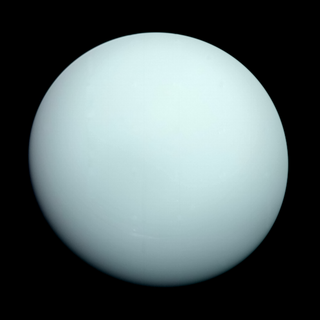
An ice giant is a giant planet composed mainly of elements heavier than hydrogen and helium, such as oxygen, carbon, nitrogen, and sulfur. There are two ice giants in the Solar System: Uranus and Neptune.
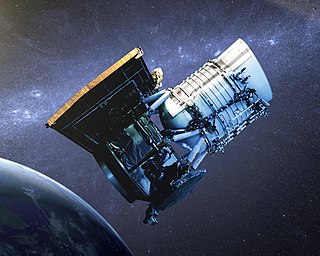
Wide-field Infrared Survey Explorer is a NASA infrared astronomy space telescope in the Explorers Program. It was launched in December 2009, and placed in hibernation mode in February 2011, before being re-activated in 2013 and renamed the Near-Earth Object Wide-field Infrared Survey Explorer (NEOWISE). WISE discovered thousands of minor planets and numerous star clusters. Its observations also supported the discovery of the first Y-type brown dwarf and Earth trojan asteroid.
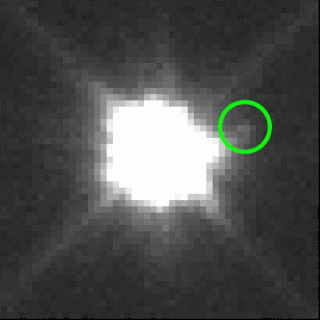
3548 Eurybates is a carbonaceous Jupiter trojan from the Greek camp and the parent body of the Eurybates family, approximately 68 kilometers in diameter. It is a target to be visited by the Lucy mission in August 2027. Discovered during the second Palomar–Leiden Trojan survey in 1973, it was later named after Eurybates from Greek mythology. This C-type asteroid is among the 60 largest known Jupiter trojans and has a rotation period of 8.7 hours. Eurybates has one kilometer-sized satellite, named Queta, that was discovered in images taken by the Hubble Space Telescope in September 2018.

Neptune is the eighth planet from the Sun and the farthest IAU-recognized planet in the Solar System. It is the fourth-largest planet in the Solar System by diameter, the third-most-massive planet, and the densest giant planet. It is 17 times the mass of Earth, and slightly more massive than its near-twin Uranus. Neptune is denser and physically smaller than Uranus because its greater mass causes more gravitational compression of its atmosphere. Being composed primarily of gases and liquids, it has no well-defined solid surface. The planet orbits the Sun once every 164.8 years at an average distance of 30.1 astronomical units. It is named after the Roman god of the sea and has the astronomical symbol , representing Neptune's trident.

MAVEN is a NASA spacecraft orbiting Mars to study the loss of that planet's atmospheric gases to space, providing insight into the history of the planet's climate and water. The name is an acronym for "Mars Atmosphere and Volatile Evolution" while the word maven also denotes "a person who has special knowledge or experience; an expert". MAVEN was launched on an Atlas V rocket from Cape Canaveral Air Force Station, Florida, on 18 November 2013 UTC and went into orbit around Mars on 22 September 2014 UTC. The mission is the first by NASA to study the Mars atmosphere. The probe is analyzing the planet's upper atmosphere and ionosphere to examine how and at what rate the solar wind is stripping away volatile compounds.

Transiting Exoplanet Survey Satellite is a space telescope for NASA's Explorer program, designed to search for exoplanets using the transit method in an area 400 times larger than that covered by the Kepler mission. It was launched on 18 April 2018, atop a Falcon 9 launch vehicle and was placed into a highly elliptical 13.70-day orbit around the Earth. The first light image from TESS was taken on 7 August 2018, and released publicly on 17 September 2018.

The Uranus Orbiter and Probe is an orbiter mission concept to study Uranus and its moons. The orbiter would also deploy an atmospheric probe to characterize Uranus's atmosphere. The concept is being developed as a potential large strategic science mission for NASA. The science phase would last 4.5 years and include multiple flybys of each of the major moons.
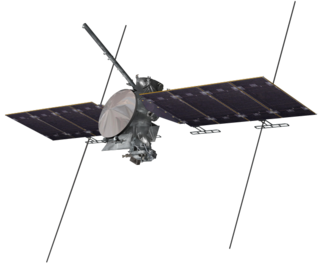
Europa Clipper is an interplanetary mission in development by NASA comprising an orbiter. Planned for launch in October 2024, the spacecraft is being developed to study the Galilean moon Europa through a series of flybys while in orbit around Jupiter.
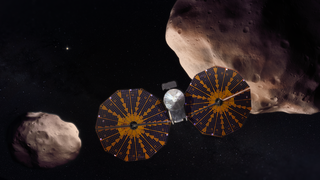
Lucy is a NASA space probe on a twelve-year journey to eight different asteroids, visiting two main belt asteroids as well as six Jupiter trojans, asteroids which share Jupiter's orbit around the Sun, orbiting either ahead of or behind the planet. All target encounters will be flyby encounters. The Lucy spacecraft is the centerpiece of a US$981 million mission.
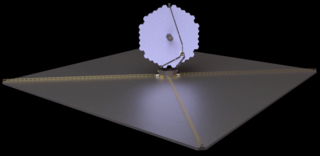
The Large Ultraviolet Optical Infrared Surveyor, commonly known as LUVOIR, is a multi-wavelength space telescope concept being developed by NASA under the leadership of a Science and Technology Definition Team. It is one of four large astrophysics space mission concepts studied in preparation for the National Academy of Sciences 2020 Astronomy and Astrophysics Decadal Survey.

The Europa Lander is a proposed astrobiology mission concept by NASA to send a lander to Europa, an icy moon of Jupiter. If funded and developed as a large strategic science mission, it would be launched in 2027 to complement the studies by the Europa Clipper orbiter mission and perform analyses on site.

Carrie Anderson is an American planetary scientist at NASA's Goddard Space Flight Center.
Trident is a space mission concept to the outer planets proposed in 2019 to NASA's Discovery Program. The concept includes flybys of Jupiter and Neptune with a focus on Neptune's largest moon Triton.

Neptune Odyssey is an orbiter mission concept to study Neptune and its moons, particularly Triton. The orbiter would enter into a retrograde orbit of Neptune to facilitate simultaneous study of Triton and would launch an atmospheric probe to characterize Neptune's atmosphere. The concept is being developed as a potential large strategic science mission for NASA by a team led by the Applied Physics Laboratory at Johns Hopkins University. The current proposal targets a launch in 2033 using the Space Launch System with arrival at Neptune in 2049, although trajectories using gravity assists at Jupiter have also been considered with launch dates in 2031.
















